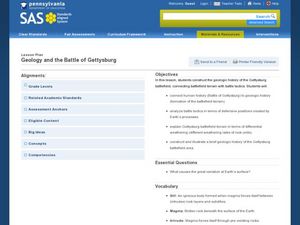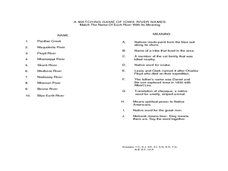Curated OER
Mud Splat Craters
Students simulate crater formation using mud. In this earth science lesson, students identify the features of a crater. They explain how the force of impact affect the crater's appearance.
Curated OER
The Path of Pollution
Students examine the path of pollution that was created by the Chernobyl accident. They discover how air pollution travels from one area to another and sequentially locate the countries where radiation traveled to.
Curated OER
Plan For The Shot Put
Pupils participate in 5 activities that lead into the correct progression for the shot put. Activities include grip and arm position, release, putting, standing puts, and reverse puts. This lesson includes safety tips, and equipment needed.
Curated OER
Geology and the Battle of Gettysburg
Young scholars create geologic maps of the Gettysburg battlefield. In this geologic skills lesson, students consider the variations of Earth's surfaces and explore strategies employed by the North and South in the Battle of Gettysburg to...
Curated OER
Mosaic Pavement Panel
Students analyze Mosaic art and identify the tessellation process. In this Mosaic art lesson, students read information about Mosaic art and the tessellation process. Students compare mosaics from various civilizations and construct...
Curated OER
Keep It Clean…Or Pass It Around
Learners identify the harmful and beneficial effects of bacteria. In this biology lesson, students test the effectiveness of antibacterial cleaners. They create a presentation based on researched information and experimental results.
Curated OER
The Path of Pollution
Students name and locate countries where radiation from the Chernobyl accident traveled, describe how air pollution travels from one area to another and list the travel of radiation in chronological order.
Curated OER
Space
First graders examine space in this unit of lessons. They create a KWL chart and write in their journals about space. They also examine the phases of the moon and identify the constellations.
Curated OER
Earth: The Apple of our Eye
Students are led through a demonstration in which they cut open an apple, which represents the earth. They follow through the hands-on lesson, cutting the apple into various portions--each representing some aspect of the earth.
Curated OER
Unique Plants of the Biomes
Students examine how the earth is divided into different biomes that are characterized by a distinctive climate. In this earth's surface lesson plan students identify adaptations of plants in specific biomes.
Curated OER
Fabulous Forensic Fingerprints
Students observe their fingerprints and notice how all human bodies are different. For this fingerprints lesson plan, students see the loops, whorls, and arches that make everyone's fingerprints different, and make a class graph for...
Curated OER
Geography: why is Arkansas a great place to grow rice?
Second graders become familiar with the geography of Arkansas and analyze why it is a good place for certain crops to grow. In this rice lesson, 2nd graders list reasons Arkansas is a good place to grow rice. Students become familiar...
Curated OER
Sociology: What is life like for Gulf Coast rice farmers
Students read 1 page about Gulf Coast rice farmers and then describe what rice farming in the U.S. is like in the United States. In this rice farming lesson plan, students tell why they would or would not want to be a rice farmer.
Curated OER
Airplane Wings
Students examine the aerodynamics of a wing and how it generates lift. In this flight lesson students complete several experiments including how to build a paper plane and how airfoils affect performance.
Curated OER
Creating a 3d Model and Corresponding Topographic Map
Young scholars create a landform model and topographic map. In this topography lesson, learners use a real landform to create a model and topographic map to scale.
Curated OER
Controlling the Flow of the Colorado River: A Study of Dams
Students research and map the Colorado River and its dams and predict the effects of a dam on an area. They suggest reasons a dam would be built and compare the Colorado River system with other major river systems within the US and...
Curated OER
Greece: The Landscape
Learners work in small groups to create a topographic map of Greece. They must include labeled line drawings of bordering countries and bodies of water. Students use salt and flour clay to make Greece three dimensional, showing the many...
Curated OER
URBAN WILDERNESS AND PARKS
Student examine the need for and the problems of wilderness areas which are located close to urban centers. They discuss their concept of wilderness, write down their perceptions and report to the class.
Curated OER
The Brain Reflex System And How It Works
Students explore reflexes. In this biology lesson plan, students discover the basic facts about the reflex systems of the brain as they take part in hands-on activities.
Curated OER
Rainbow Milk
Students complete activities to learn about rainbows and the importance of dairy in their diet. In this sense and diet lesson, students discuss rainbow colors, the importance of sight, and the importance of dairy in a healthy diet....
Curated OER
What's a Swamp Good For?
Students identify the function and value of wetlands. In this instructional activity on appreciating wetlands, students explain how different household items can represent different aspects of the wetlands.
Curated OER
Landforms of Iowa
Students observe the landscape and different landforms where they live. In this landforms lesson students list and define materials that make up their local landforms.
Curated OER
Not Only a Drought
Pupils explore the events that occurred during the Dust Bowl and differentiate between the good and bad agricultural practices. In this Dust Bowl lesson plan students participate in activities that shows them how to be good stewards of...
Curated OER
Volcano Under the City
Students examine the different flow rates of liquids and how lava's viscosity influences flow. For this liquids lesson students complete several handouts and a lab activity.

























